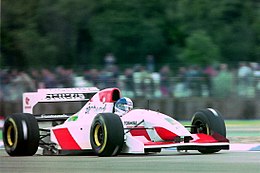 Derek Warwick driving the FA14 at the 1993 British Grand Prix | |||||||||
| Category | Formula One | ||||||||
|---|---|---|---|---|---|---|---|---|---|
| Designer(s) | Alan Jenkins (Technical Director) Dave Amey (Chief Designer) | ||||||||
| Predecessor | FA13 | ||||||||
| Successor | FA15 | ||||||||
| Technical specifications | |||||||||
| Chassis | Carbon fibre monocoque | ||||||||
| Axle track | Front: 1,676 mm (66.0 in) Rear: 1,600 mm (63 in) | ||||||||
| Wheelbase | 2,946 mm (116.0 in) | ||||||||
| Engine | Mugen Honda MF-351 HB, 3,500 cc (213.6 cu in), V10, NA, mid-engine, longitudinally-mounted | ||||||||
| Transmission | Footwork / Xtrac 6-speed Semi-automatic | ||||||||
| Power | 720 hp (536.9 kW) @ 13,200 rpm[1] | ||||||||
| Weight | 510 kg (1,120 lb) | ||||||||
| Fuel | BP | ||||||||
| Tyres | Goodyear | ||||||||
| Competition history | |||||||||
| Notable entrants | Footwork Mugen-Honda | ||||||||
| Notable drivers | 9. 10. | ||||||||
| Debut | 1993 European Grand Prix | ||||||||
| Last event | 1993 Australian Grand Prix | ||||||||
| |||||||||
The Footwork FA14 was a Formula One car with which the Footwork team competed in part of the 1993 Formula One season. It replaced the FA13B, a revised version of the previous year's FA13 chassis that had been used for the first two races of that season. It was driven by veteran Derek Warwick, returning from a two-year sabbatical, and Aguri Suzuki, retained from 1992.[2]
- ^ "Engine Mugen Honda". www.statsf1.com. Retrieved 14 December 2020.
- ^ Boxall-Legge, Jake (13 November 2023). "The contrasting fortunes of 1993's bottom six F1 teams". Autosport. Retrieved 14 November 2023.